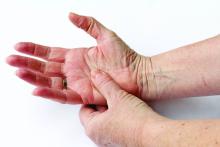Patients with hand osteoarthritis (OA) and MRI-detected synovitis who took methotrexate (MTX) 20 mg weekly over a 6-month period had a significant and potentially clinically meaningful reduction in pain and stiffness over those who received placebo in the first randomized controlled trial of its kind to show positive results with the drug.
Patients who were randomly assigned to MTX took 10 mg orally for the first 4 weeks then increased to 20 mg for the rest of the trial, with differences in the primary outcome of pain measured by visual analog scale (VAS) first becoming significant over placebo at 3 months.
Senior author of the METHODS study (Methotrexate to Treat Hand Osteoarthritis with Synovitis), Flavia Cicuttini, PhD, MSc, head of the musculoskeletal unit at Monash University and head of rheumatology at Alfred Hospital, Melbourne, Australia, noted that the effect of MTX was higher than effect sizes that have been reported for NSAIDs on pain in hip or knee OA.
The study was published online October 12 in The Lancet.
METHODS makes improvements on past studies
While OA is traditionally categorized as a noninflammatory process, it’s known that there are some patients who have a clinical phenotype characterized by joint swelling (synovitis) and others develop erosive disease. MTX is one of the most common therapies for inflammatory arthritis and standard of care for rheumatoid arthritis (RA) management. Previous studies of methotrexate showed lack of efficacy in hand OA but may have been because of the use of a low dose, poor power due to moderate sample size, and failure to target the specific inflammatory OA phenotype.
In an interview, Dr. Cicuttini noted the selection of methotrexate for this trial was intentional. “We considered the evidence and decided to test methotrexate because we know it is effective in inflammatory arthritis, and its mode of action is broader than the more selective anti-TNF [tumor necrosis factor] agents,” which she noted have failed in prior hand OA trials. She also noted that the only previous randomized controlled trial of MTX tested a dose of 10 mg/week, rather than the 20 mg/week dose used in METHODS.
Study details and results
METHODS was a randomized, double-blind, placebo-controlled trial at multiple sites within Australia. Patients were recruited from 2017 to 2022, with a temporary pause in 2020 during the COVID-19 pandemic because of safety concerns regarding MTX use. Participants included in this study were aged 40-75 years, had pain in hand joints for most days in the past 3 months, and a pain score of at least 40 mm on a 100-mm VAS in the past 7 days.
The participants’ hand OA fulfilled American College of Rheumatology criteria, radiographic osteoarthritis (Kellgren and Lawrence grade 2 or more) in at least one joint, and MRI-detected synovitis of grade 1 or more in at least one joint. They excluded patients with concomitant rheumatic disease, gout, psoriasis, positive rheumatoid factor or anti-cyclic citrullinated peptides, or elevated inflammatory markers (erythrocyte sedimentation rate or C-reactive protein), as well as those with contraindication to methotrexate or MRI.
The trials’ 97 participants were assigned 1:1 to MTX or placebo using block randomization. The MTX group started on oral MTX 10 mg weekly for the first 4 weeks, followed by 20 mg weekly for the remainder of the study. Participants took folic acid 5 mg once a day to reduce risk of MTX-related side effects.
The mean age of the participants was 61 years, with 70% female. Baseline characteristics were generally well-balanced, except for higher mean BMI in the MTX group. At 6 months, the MTX group had a greater reduction in mean VAS pain than the placebo group (–15.2 mm vs. –7.7 mm; adjusted between-group difference, –9.9 mm). The minimally clinically important difference for OA trials is a 15-mm change (out of 100) in VAS pain.
The MTX group also had greater reduction in mean Australian Canadian OA Hand Index (AUSCAN) score for pain and stiffness at 6 months, compared with placebo, but there were no differences in other secondary outcomes (mean AUSCAN, Functional Index for Hand Osteoarthritis, Health Assessment Questionnaire, Michigan Hand Outcomes Questionnaire, or grip strength).
MTX was well-tolerated with no serious adverse events related to treatment; only 5 of 50 participants in the MTX group and 4 of 47 in the placebo group discontinued study medication. Incidence of adverse events was similar in the two groups throughout the trial, including mild leukopenia, elevated liver enzymes, mild reduction of hemoglobin, and raised creatinine. None of the laboratory abnormalities required change in medication dosage or affected ability to continue in the study.



